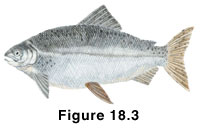 Description
DescriptionOncorhynchus mykiss
(Steelhead Trout)
a.k.a Salmo gairdneri
(Other common names: Rainbow Trout, Metalhead, Salmon Trout)
Figure 18.3
 Description
DescriptionLength: up to 114 cm.
Mouth: large, terminal, directed forward; upper jaw extends to the posterior edge of orbit; snout blunt; lips fleshy; teeth in jaws small, well developed, conical and hooked inwards on the maxillaries, premaxillaries, madibles, palatines, the shaft of vomer and the tongue (but not at back of tongue); no red colouration on lower jaw.
Body: elongate; caudal peduncle compressed; caudal fin slightly forked; adipose fin small and slender; 17-21 gill rakers over the first gill arch.
Color: metallic blue on dorsal with silvery sides; black spots on dorsal, back and caudal fins; spawning males have reddish band on side.
Depth: pelagic schooling species.
Habitat: freshwater and anadromous in coastal waters (freshwater fish are rainbow trout, marine are steelhead).
Season: spawning can occur in both summer and winter in gravelly rivers; young will remain in freshwater for two to three years; marine phase can last two to three years.
Diet: in freshwater systems will eat insect, worms, smaller minnow species; marine adults eat forage fish species (e.g., greenlings, herring, sand lance), crustaceans (e.g., copepods, euphasiids, amphipods).
Predators: larger fish species, sea birds, marine mammals, and terrestrial mammals.
Distribution: Mexico to Alaska.
 Scale
Description
Scale
DescriptionRelative Size of Scale: large.
Position of Scales on Body: in rows above the lateral line canal 118-147; also on the lateral line canal 121-140 (Hart, 1973).
Overall Scale Shape: circular to somewhat oval anterior field, the posterior field is rounded, at times can be irregular.
Focus and Circuli: focus is clearly defined and is slightly offset between the fields; often just anterior to the interface of the posterior field. The circuli are concentric with the scale outline. Circuli are generally continuous between the lateral and anterior fields but a small number of discontinuous circuli may also be present. The posterior field is transparent and discontinuous circuli and/or reticulation patterns may be present.
Radii: absent
Remarks: Mosher (1969) indicated that the freshwater region is large with bold circuli and one and three (sometimes more winter marks); freshwater circuli can continue into the posterior field; oceanic circuli are continuous but not as likely to enter the posterior field and may show as weak striations, they are: discontinuous; granular reticulation are present; more than one spawning check may be present.
In our core material from Effingham Inlet no salmon scales have been observed thus far, even though salmon are present in the ecosystem. Although salmon scales are not decidous, this is not the only factor pertaining to their absence as we do find other non-deciduous species preserved. It is possible that these scales are too fragile, or too susceptible to erosion (chemical), and are thus poor candidates for preservation.